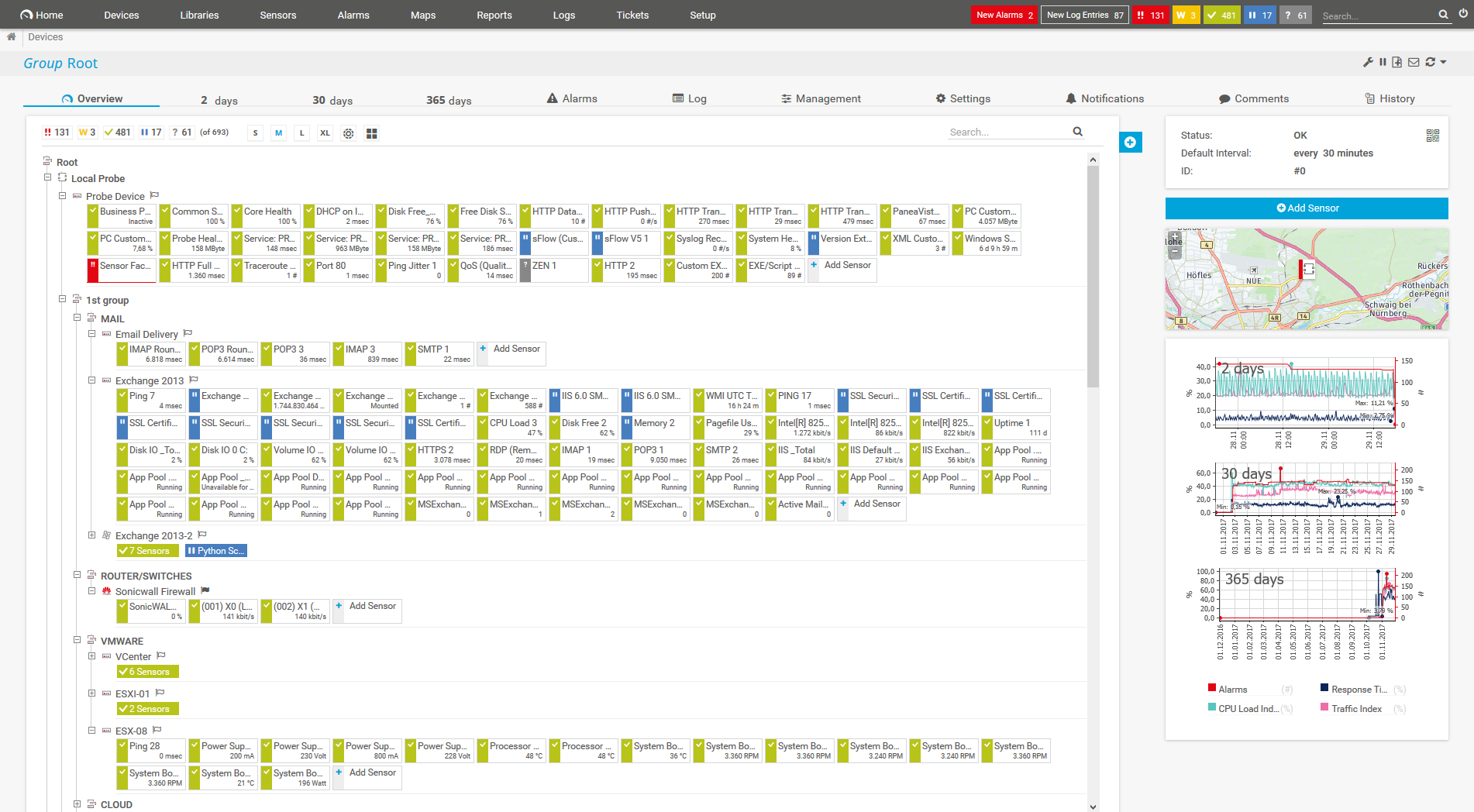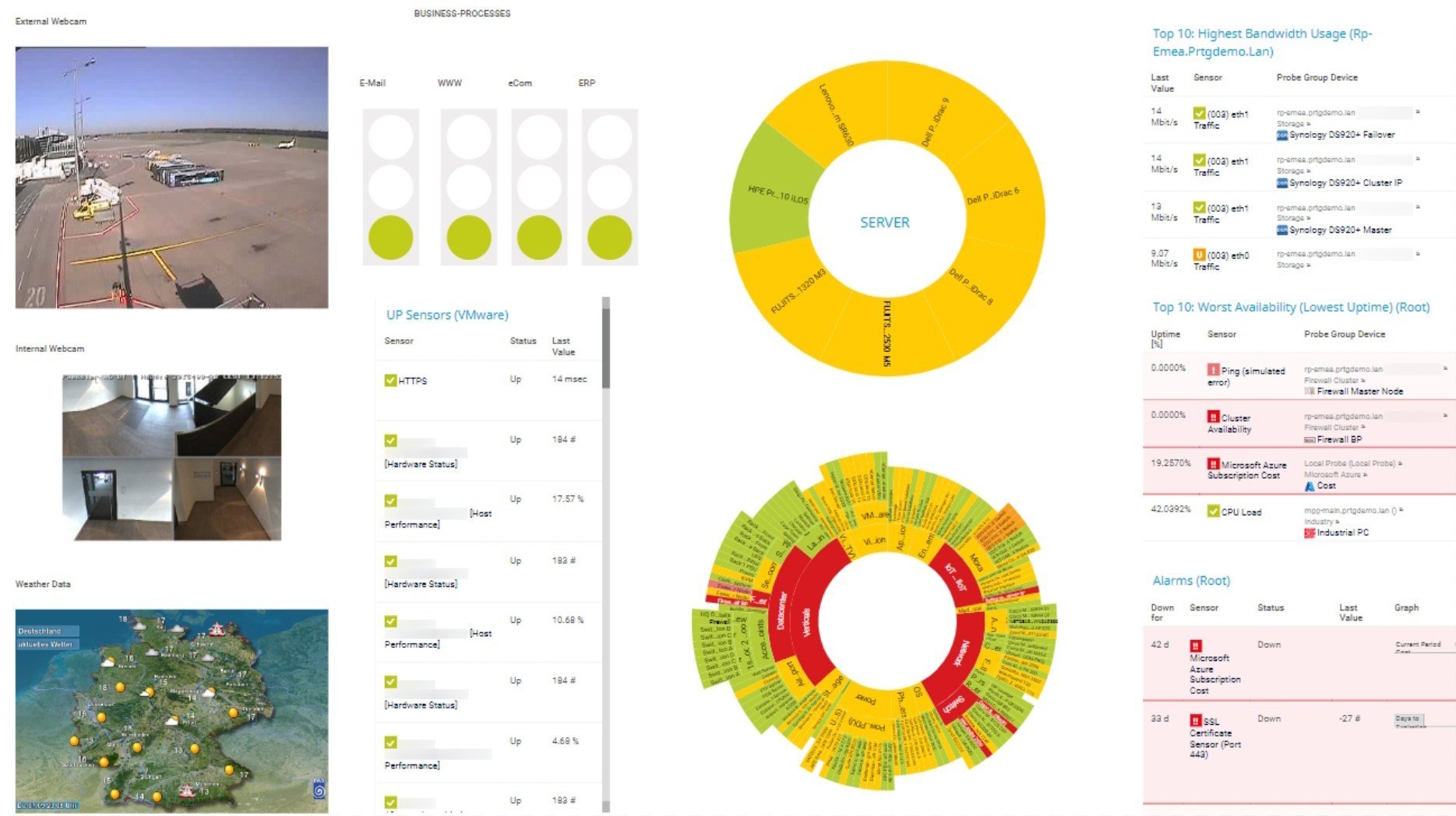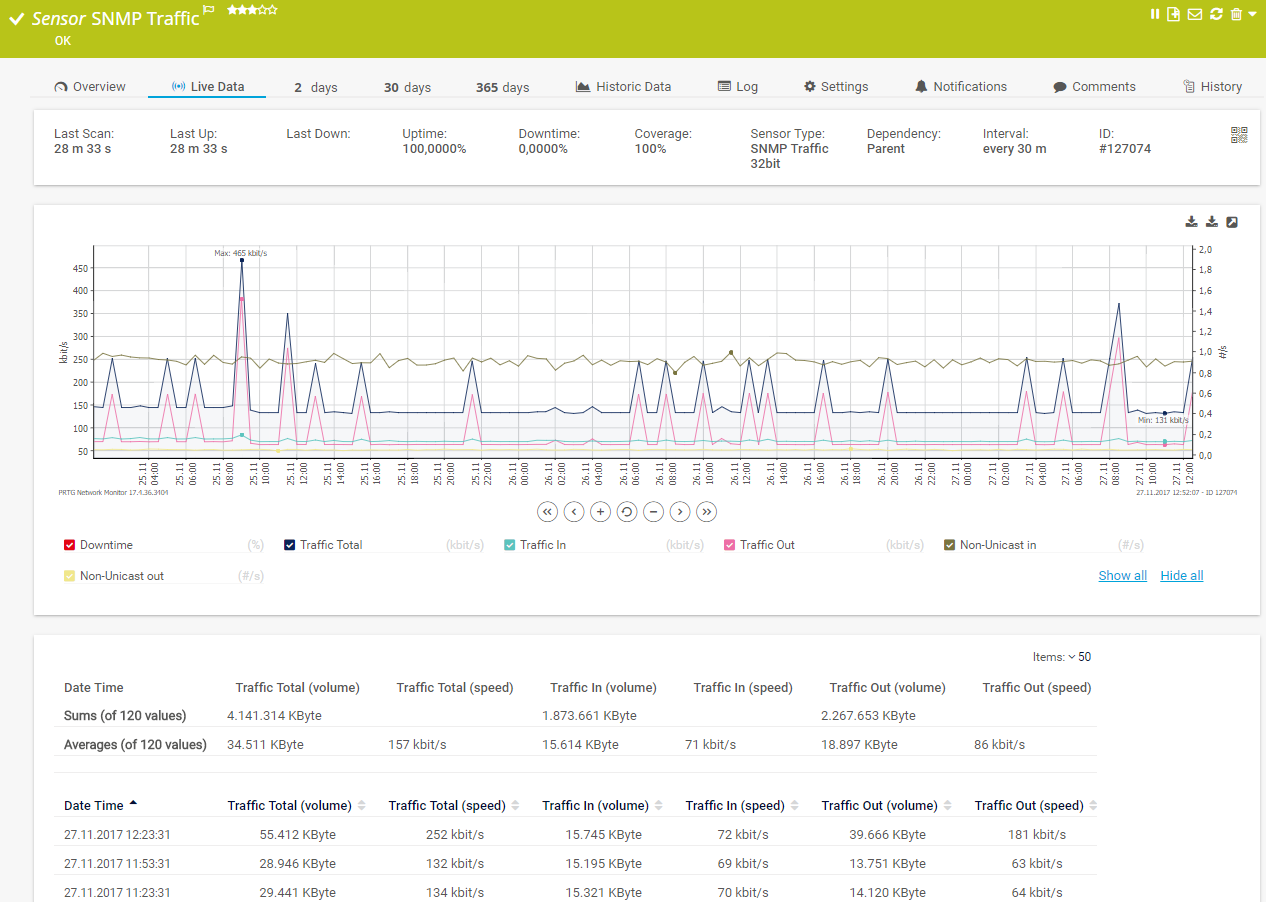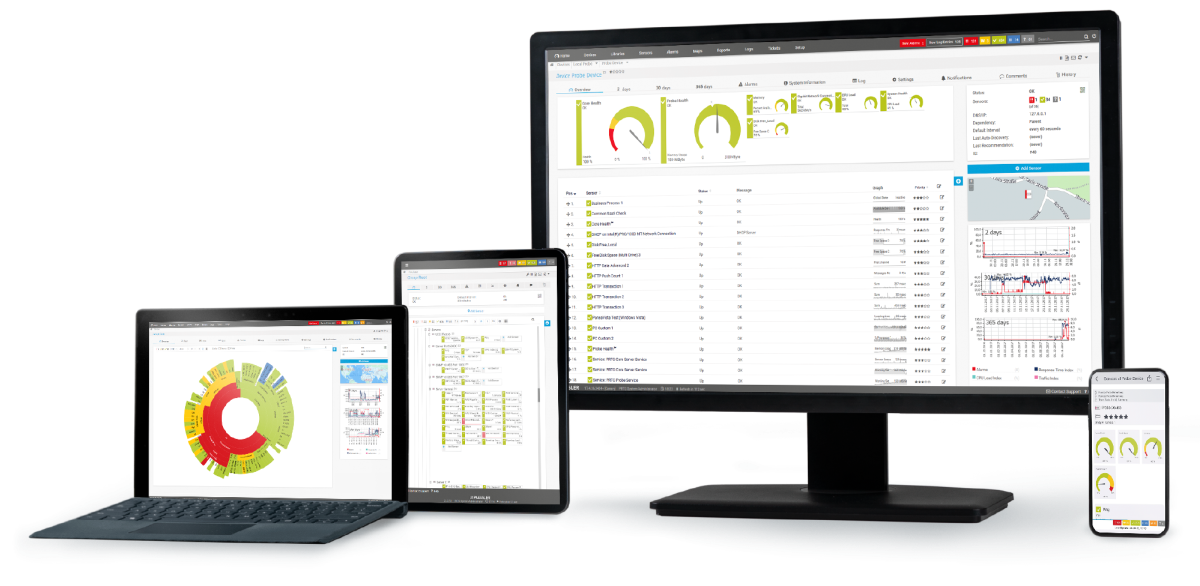Custom alerts and data visualization let you quickly identify and prevent low availability and unplanned downtime.
Diagnose network issues and outages by continuously tracking all your network devices including servers, routers, workstations, and DHCP scope monitoring. Show ping response times and other key metrics in real time. Visualize monitoring data in clear graphs and dashboards to identify problems more easily. Gain the overview you need to troubleshoot network connection issues.

Device tree view of the complete monitoring setup

Custom PRTG dashboard for keeping an eye on the entire IT infrastructure

Live traffic data graph in PRTG
The command line is still a commonly used way to execute a ping query, particularly when a malfunction or urgent issue occurs and you need to quickly an IP address or a service check for availability.
Our network monitoring software monitors the availability and reachability of all your network devices and connections 24/7. Gone are the days of manual monitoring - PRTG runs in the background and automatically alerts you if there is an issue in your network. Ping monitoring is one of the core functionalities of PRTG; but with our software, you can also comprehensively monitor your entire network, your applications, your traffic, and more.
Some ping monitoring tools do nothing more than running ping tests. These tools are often free of charge. Other tools, such as PRTG, are comprehensive network monitoring solutions. The advantage of an all-in-one monitoring solution: all your monitoring tasks are performed in one central tool. Although, if you have an extremely small network, it is sufficient to start with a simple ping tool.
Network monitoring tools include open-source applications like Nagios and proprietary software like PRTG. Our software is easy to set up, can be easily upgraded, and comes with outstanding technical support. As a result, many companies switch from their open-source tools to PRTG. See for example our comparison of Nagios and PRTG.
PRTG comes with more than 250 native sensor types for monitoring your entire on-premises, cloud, and hybrid cloud environment out of the box. Check out some examples below!
See the PRTG Manual for a list of all available sensor types.
Custom alerts and data visualization let you quickly identify and prevent low availability and unplanned downtime.
PRTG is set up in a matter of minutes and can be used on a wide variety of mobile devices.

Partnering with innovative IT vendors, Paessler unleashes synergies to create
new and additional benefits for joined customers.
By integrating PRTG with Martello iQ, you can add a fast analytics layer to improve uptime, visualize your IT environment, and integrate all of your IT systems into a single pane of glass.
Paessler and Plixer provide a complete solution adding flow and metadata analysis to a powerful network monitoring tool.
Siemon and Paessler bring together intelligent building technology and advanced monitoring and make your vision of intelligent buildings and data centers become reality.
Real-time notifications mean faster troubleshooting so that you can act before more serious issues occur.
Network Monitoring Software – Version 25.3.110.1313 (August 27, 2025)
Download for Windows and cloud-based version PRTG Hosted Monitor available
English, German, Spanish, French, Portuguese, Dutch, Russian, Japanese, and Simplified Chinese
Network devices, bandwidth, servers, applications, virtual environments, remote systems, IoT, and more
Choose the PRTG Network Monitor subscription that's best for you
Ping is a command-line utility which is available on almost any operating system with network connectivity. It acts as a test to see if a networked device is reachable. The ping command sends a request over the network to a specific target device. A successful ping results in a response from the device that was pinged to the source system. Usually, ping is used to check the availability of a device and measure the round-trip time of the request and response.
A ping test shows you if a source system is able to connect to a target device, that is, if this device is available. It is an extremely simple diagnostic tool for getting a general idea of a device's availability. It does not, however, tell you how well individual devices are running. For this, you need a more detailed analysis, for example via SNMP, WMI, or SSH.
Ping monitoring is the process of pinging devices in a network with a monitoring software like PRTG to find out if they are available. With the data that a pinged device sends back, the monitoring tool can measure and analyze minimum, maximum, and average response time and deviations from the sent ping.
In a local network, a ping value of one millisecond is considered normal. On the Internet, it depends on the application. A video conference requires a lower ping value than a request to a website. A ping value of less than 100 milliseconds is preferable, but a value of around 500 milliseconds is often still acceptable for a reasonable user experience.
Every system administrator can immediately tell if a ping value is too high. High ping values usually lead to more work for the technical support team because they can indicate, for example, that network connections or telephone services are down. Therefore, it is always good to know about your ping times with a ping monitoring software like PRTG.
When you install PRTG, the tool automatically pings all network devices within a specified IP range and incorporates them into your monitoring environment. Such devices can be, for example, routers, switches, servers, or stationary computers. This way, you don't have to do anything to set up your initial monitoring.
PRTG uses Ping sensors to monitor the availability of your network devices. It pings the devices in your network and waits for a response. This way, it can measure, for example, the response time of a device, that is, the time it takes the device to send back a response to the PRTG core server system.
Yes, our software can also be used to ping devices in distributed networks. PRTG uses remote probes to connect other locations to your central monitoring environment. If something goes wrong, you are alerted in real time so that you can take action at once.
Our ping monitoring tool monitors your network devices around the clock. You can individually set the threshold values that trigger an alert when they exceed or fall below a specific value. If a device fails, PRTG notifies you at once.
Yes, PRTG provides comprehensive DHCP monitoring capabilities to ensure your network's IP address infrastructure runs smoothly. Our DHCP monitoring solution tracks server availability, monitors IP pool utilization, and provides real-time alerts when issues arise.
DHCP scope monitoring is a key component that tracks individual IP address ranges within your DHCP infrastructure to prevent IP exhaustion and optimize address allocation. With DHCP scope monitoring, you can monitor scope utilization rates, track lease distribution, and receive proactive notifications before scopes reach capacity limits.
This integrated approach to DHCP monitoring helps prevent network connectivity issues, reduces troubleshooting time, and ensures optimal IP address management across your entire infrastructure. PRTG's DHCP monitoring sensors work alongside our ping monitoring capabilities to provide complete visibility into your network's connectivity and address management systems.
In PRTG, “sensors” are the basic monitoring elements. One sensor usually monitors one measured value in your network, for example the traffic of a switch port, the CPU load of a server, or the free space on a disk drive. On average, you need about 5-10 sensors per device or one sensor per switch port.
Paessler conducted trials in over 600 IT departments worldwide to tune its network monitoring software closer to the needs of sysadmins. The result of the survey: over 95% of the participants would recommend PRTG – or already have.
Paessler PRTG is used by companies of all sizes. Sysadmins love PRTG because it makes their job a whole lot easier.
Bandwidth, servers, virtual environments, websites, VoIP services – PRTG keeps an eye on your entire network.
Everyone has different monitoring needs. That’s why we let you try PRTG for free.